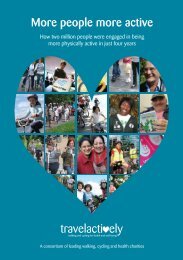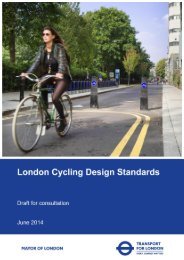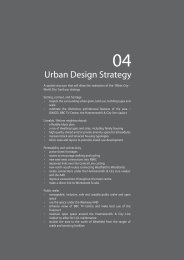Travel in London Travel in London
travel-in-london-report-8
travel-in-london-report-8
Create successful ePaper yourself
Turn your PDF publications into a flip-book with our unique Google optimized e-Paper software.
9. <strong>London</strong>’s air quality and greenhouse gas emissions and transport and public health<br />
physical activity each week <strong>in</strong> periods of ten m<strong>in</strong>utes or more. This is the level of<br />
activity recommended by the Chief Medical Officer for avoid<strong>in</strong>g the greatest health<br />
risks associated with a lack of physical activity such as Type 2 diabetes, depression,<br />
coronary heart disease and some cancers. Moderate-<strong>in</strong>tensity aerobic activity<br />
<strong>in</strong>cludes brisk walk<strong>in</strong>g and cycl<strong>in</strong>g. New evidence is <strong>in</strong>dicat<strong>in</strong>g that active travel is<br />
prov<strong>in</strong>g to be the biggest determ<strong>in</strong>ant of whether the population are gett<strong>in</strong>g enough<br />
exercise to stay healthy. A new study from the Netherlands (Fishman et al, 2015:<br />
Adult active transport <strong>in</strong> the Netherlands: An analysis of its contribution to physical<br />
activity requirements) analysed travel survey data to assess the contribution of<br />
active travel to adults meet<strong>in</strong>g their physical activity needs. This study found that<br />
those who did any walk<strong>in</strong>g or cycl<strong>in</strong>g at all were likely to exceed the 150 m<strong>in</strong>utes<br />
per week threshold and overall 38 per cent of Dutch adults met or exceed m<strong>in</strong>imum<br />
activity levels from active travel alone. This same central role of active travel to<br />
achiev<strong>in</strong>g physical activity recommendations has also been shown <strong>in</strong> studies for<br />
England (Belanger et al, 2011: Age related differences <strong>in</strong> physical activity profiles of<br />
English adults).<br />
Trends <strong>in</strong> active travel by age group<br />
The <strong>London</strong> <strong>Travel</strong> Demand Survey (LTDS) can be used to quantify active travel by<br />
<strong>London</strong> residents. Figure 9.8 shows the number of m<strong>in</strong>utes spent walk<strong>in</strong>g and<br />
cycl<strong>in</strong>g per adult per day for <strong>London</strong> residents. The graph shows that across all age<br />
groups there has been a general upward trend <strong>in</strong> m<strong>in</strong>utes per person per day spent<br />
travell<strong>in</strong>g actively between 2008/09 and 2014/15.<br />
Figure 9.8<br />
30<br />
Number of m<strong>in</strong>utes spent walk<strong>in</strong>g and cycl<strong>in</strong>g per person per day, by age<br />
group, 2008/09 – 2014/15.<br />
25<br />
M<strong>in</strong>utes per person per day<br />
20<br />
15<br />
10<br />
5<br />
0<br />
2008/09<br />
2009/10<br />
2010/11<br />
2011/12<br />
2012/13<br />
2013/14<br />
2014/15<br />
2008/09<br />
2009/10<br />
2010/11<br />
2011/12<br />
2012/13<br />
2013/14<br />
2014/15<br />
2008/09<br />
2009/10<br />
2010/11<br />
2011/12<br />
2012/13<br />
2013/14<br />
2014/15<br />
2008/09<br />
2009/10<br />
2010/11<br />
2011/12<br />
2012/13<br />
2013/14<br />
2014/15<br />
17-24 25-44 45-64 65+<br />
Walk<br />
Cycle<br />
Source: TfL Plann<strong>in</strong>g, Strategic Analysis.<br />
178 <strong>Travel</strong> <strong>in</strong> <strong>London</strong>, Report 8








